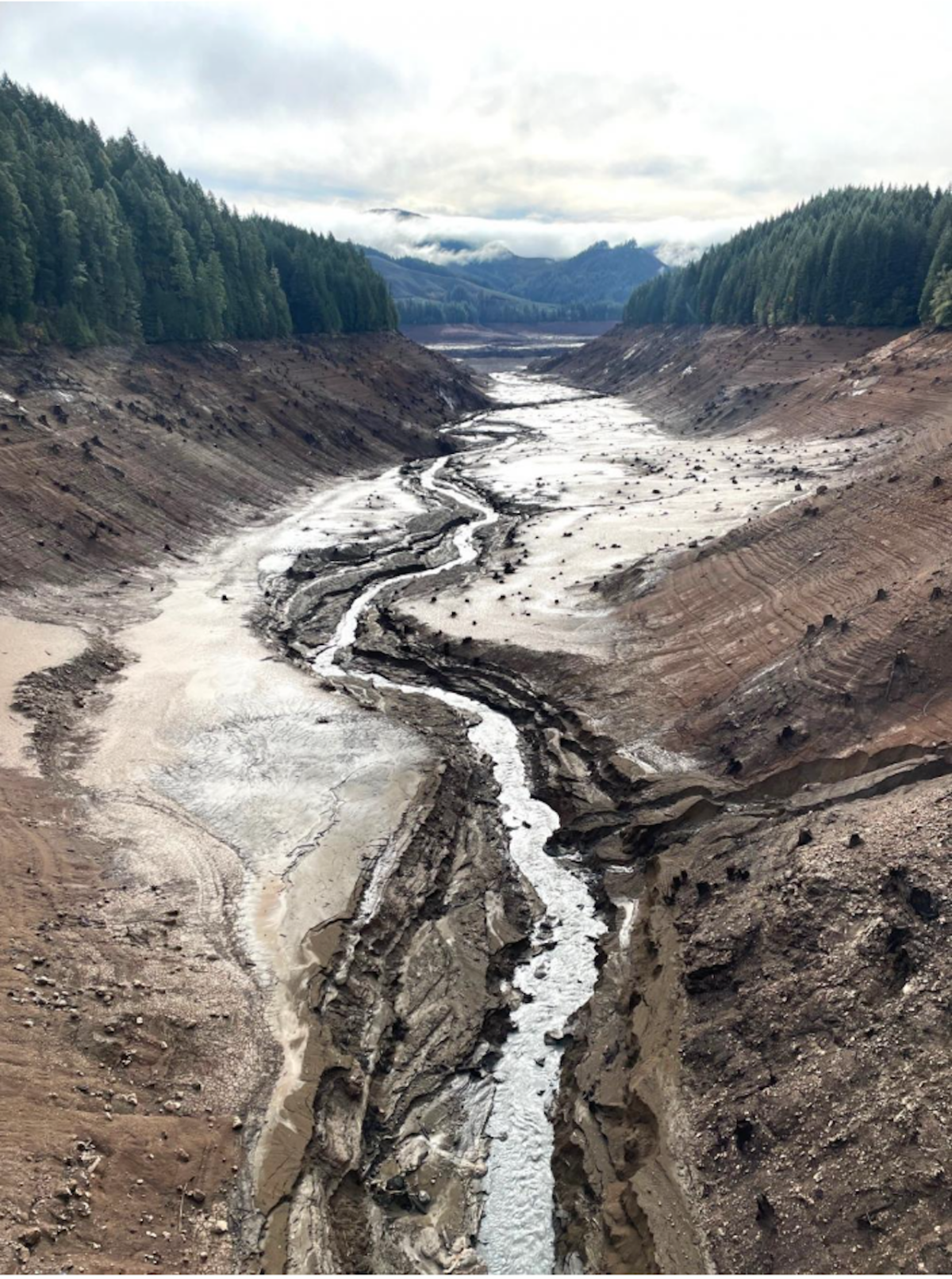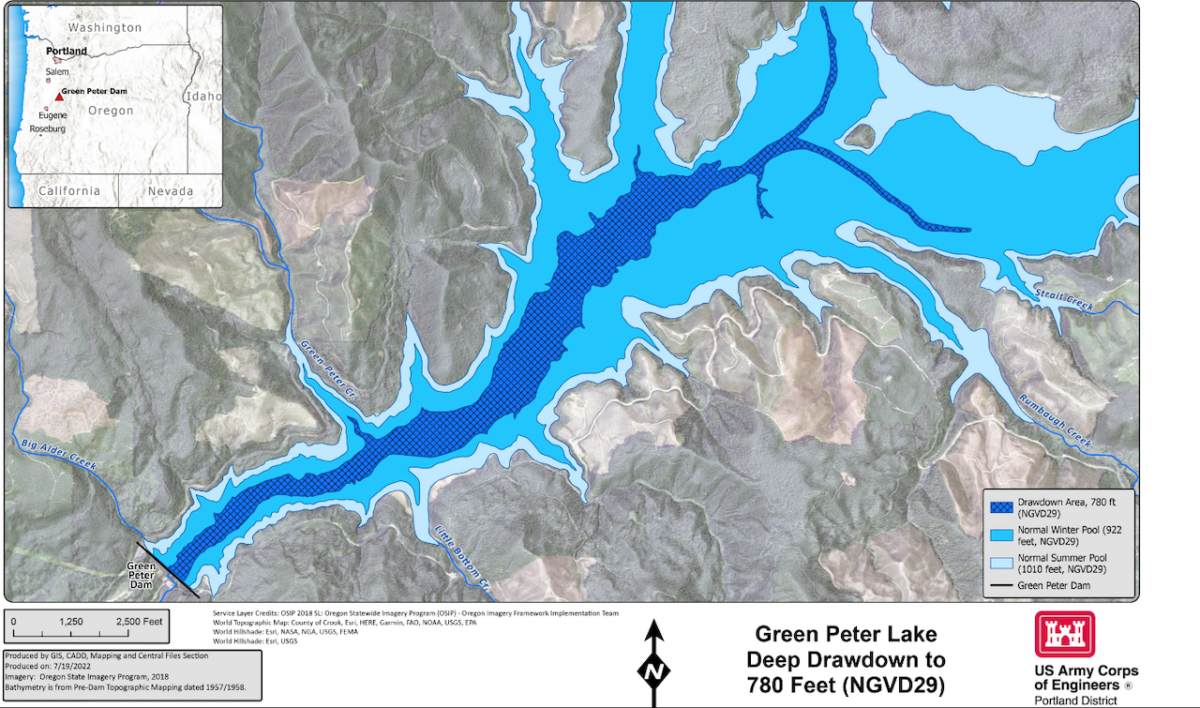
Corps Addresses Santiam Silt, Reservoir Levels In Q&A
With more mud and silt surely set to flow in the coming rainy days and weeks, the Army Corps of Engineers posted a Q&A on the federal court injunction that has led to deep drawdowns at two of its Willamette Valley reservoirs, imperiled downstream water supplies and killed fish.
A number of questions address the impact on fish and the environment, including whether the project is meant to help fishing and local stocks.

The answer: “The deep drawdown of Green Peter Reservoir has been designed to help ESA-listed Spring Chinook and winter steelhead juveniles move downstream of Green Peter Dam so they can migrate to the ocean and mature before returning to freshwater spawn. This operation was not designed to help recreational fishing or other fish species.”
Both fish species are listed under the Endangered Species Act and the Corps’ flood control system in the Willamette Valley was the subject of a long-running lawsuit from the Native Fish Society and others that came to a head in 2021 when a US District Court judge in Portland ordered the drawdowns at Green Peter on the South Santiam and Lookout Point Reservoir on the Middle Fork Willamette to improve their survival. The dams were built without upstream fish passage, but the parents of those young springers and winter-runs are trucked around the impediments, and to help the surface-oriented smolts navigate downstream the pools are dropped so they can access the dams’ lower gates.
Along with the lowering of the pools reducing some fishing access in late summer and fall, October saw a large number of kokanee sucked out of Green Peter, killing them due to barotrauma.
“We do not know what percentage of the Kokanee in the reservoir have passed downstream. The total number of Kokanee present in Green Peter Reservoir prior to this year’s drawdown is unknown, however densities of Kokanee in the reservoir were known to be high. ODFW and anglers reported that Kokanee growth rates has been constrained in the reservoir for several years, which has been attributed to the high densities. Although stocking of Kokanee occurs at Detroit Reservoir annually, ODFW has not stocked Green Peter Reservoir for several years because of the high densities of Kokanee in the reservoir,” the Corps says.

After the kokanee kill, siltation became much more apparent and worrisome in November, following the spawning of most salmon, which the feds address in another answer:
“Turbidity levels downstream of Foster Reservoir as a result of the Green Peter deep drawdown indicate that the suspended sediment transported through Green Peter Dam are remaining in suspension over long distances. It is uncertain if sediments are impacting Chinook eggs laid into gravels (redds) below Foster Dam at this time. Impacts from elevated turbidity on downstream spawning beds was monitored during the drawdown of Cougar Reservoir when the water temperature control tower construction conducted in the early-2000s. Data from that monitoring showed minor impacts on redds.”
However, there may be more serious problems at a local hatchery that rears spring Chinook and hatchery steelhead.
“In recent discussions with ODFW, the Corps has learned that fish located in the hatchery downstream of Foster Dam are experiencing higher parasitic loads and reductions in feeding, which may or may not be related to turbidity levels. Turbidity is known to cause inflammation in fish gills and could be causing respiratory distress,” the Corps says.
They try to put a spin on all that silt: “Although immediate health impacts may occur, sediment transport downstream of dams could also provide habitat benefits for aquatic life. Assessing sediment deposition patterns below Foster Dam after the drawdown and future high flow events will help determine any habitat changes that have occurred as a result of the sediment transported during the deep drawdown.”
While the muddy nature of the drawdowns are creating a lot of problems this season, the question of how long it might go on of if other methods are going to be put in place was also spoken to.
“Both structural and operational solutions for improved downstream fish passage are being considered at the the Corps’ Willamette Valley dams. Deeper reservoir drawdowns are currently being implemented at Cougar, Lookout Point and Green Peter reservoirs, and continuing as in past years at Fall Creek. Deeper drawdowns may continue into the future once the injunction is lifted and the Corps begins implementing the selected alternative in the ROD following the publication of the [final environmental impact statement] and new [Willamette Valley System] Biological Opinions. The DEIS Preferred Alternative includes deep drawdowns for long-term fish passage at Cougar, Fall Creek and Green Peter reservoirs and structural downstream fish passage as a solution at Lookout Point Dam. The drawdown at Lookout Point is expected to occur until the fish passage structured is in place. Future drawdowns would continue to be refined to reduce negative impacts to water quality such as elevated fall water temperatures, while continually improving conditions for downstream fish passage for ESA-listed salmonids.”
As for the status of recreation at Green Peter and Foster Reservoir just downstream, for the record the latter’s Sunnyside ramp is open and at the former, Linn County will open the Thistle Creek access when water levels rise enough for the ramp, estimated to be likely by “early February.” Corps’ parks at Green Peter are closed for the time being due to “safety concerns” around the muddy lakebed but are expected to reopen in spring.
Other question-and-answer sets focus on water quality – a major problem for downstream towns and folks on wells – and flood management (empty reservoirs tend to hold a lot more water).
Just don’t go to the feds looking for advice on how to stop the muddy mess from recurring next year or recovering expenses from the damages.
“The Corps cannot provide you legal advice, you would need to consult with an attorney. However, the Corps does not have authority or appropriations to compensate communities,” their final answer states.

